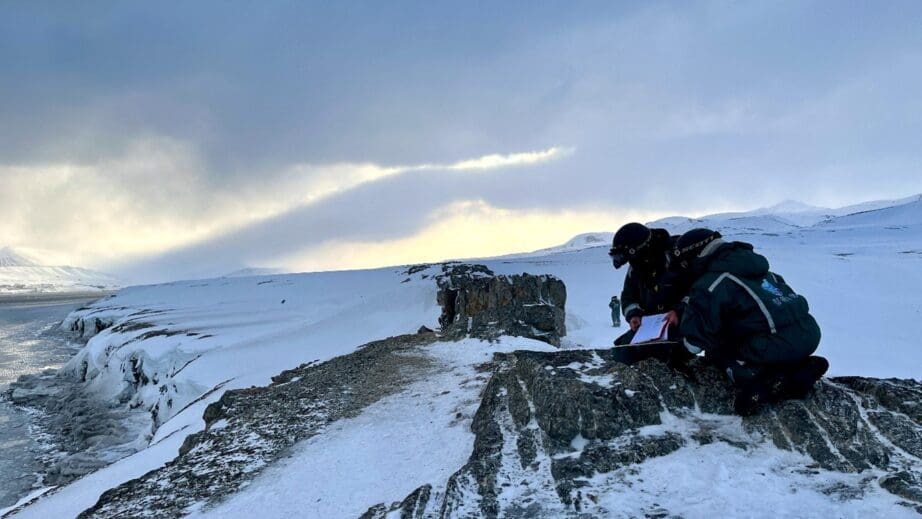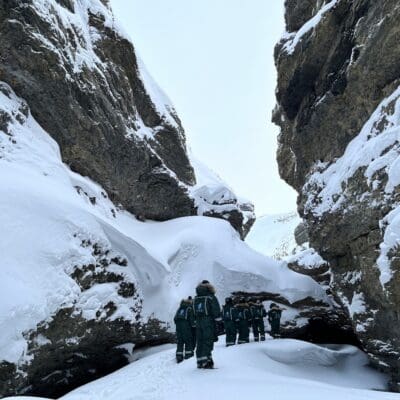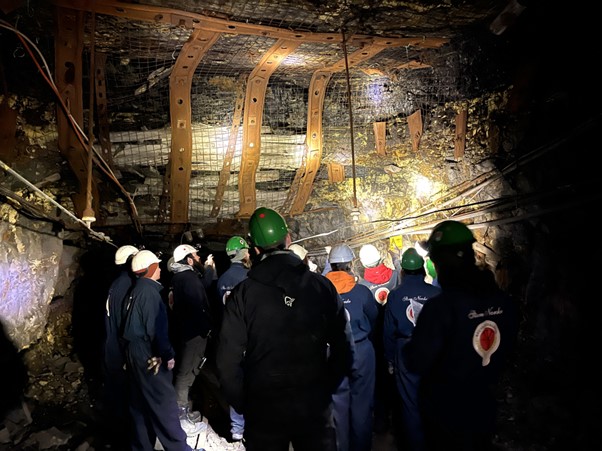AG-209 The Tectonic and Sedimentary History of Svalbard (15 ECTS)
ID:
AG-209
CREDITS:
15 ECTS
APPLICATION DEADLINE:
October 15, 2023
START DATE:
January 08, 2024
END DATE:
May 31, 2024
COURSE PERIOD:
Spring semester (Block 1-3: Week 2-22)

Students studying an outcrop at Festningen, April 2023. Photo: Marjolaine Verret/UNIS
| Grade: | Letter grade (A through F) |
| Course Cost: | Fieldwork, max. NOK 600 (app. 3 nights x NOK 200) |
| Course Capacity Min/Max: | 10/20 students |
| Language of instruction: | English |
| Examination support material: | Bilingual dictionary between English and mother tongue |
Course requirements
60 ECTS within general natural science, of which 30 ECTS within the field of geology. The applicant must be enrolled in a programme at Bachelor level, or document that the courses are approved into the applicant’s current study programme.
The course should be combined with AG-222 Integrated Geological Methods: From Outcrop to Geomodel (15 ECTS) and the two courses are designed to complement each other.
Academic content
Academic content:
In the Svalbard Archipelago there is a well-developed and well exposed stratigraphic record that comprises Precambrian, Late Palaeozoic, Mesozoic, and Cenozoic strata. The course uses published research from Svalbard combined with visiting key sites in the field to introduce students to this unique geological history “book”, which also provides onshore access to formations equivalent to the subsurface in the Barents Sea. The sedimentary rock record on Svalbard comprises siliciclastic rocks, carbonates and evaporates and we study a rift-basin setting, a foreland basin setting and the fold and thrust belt.
Learning outcomes
Upon completing the course, the students will:
Knowledge
- be familiar with the tectonic and sedimentary evolution of Svalbard from the Precambrian to the Cenozoic, with focus on the tectonic and sedimentary development since the Devonian
- be able to describe the main changes in depositional environments in Svalbard and the adjacent Barents Sea, the main tectonic phases, and climatic events.
Skills
- be able to do sedimentological logging, description, and analysis of relevant formations both in the field and in cores
- be able to describe large-scale geological structures such as folds and faults in the field and draw geological sketches and profiles
- be able to recognize common fossils from the geological record on Svalbard
- be able to carry out small independent research projects on the geology of Svalbard and present findings to others.
General competences
- be able to conduct field work under Arctic conditions,
- be able to read and analyse scientific literature
- find and combine different types of data into a joint result
- be able to collect data in the field and compare own results to published material
- demonstrate active participation in group work and be able to communicate field work results through oral presentations and scientific writing.
Learning activities
The course extends over a full semester. Initially, students attend one week of compulsory AS-101 Arctic survival and safety training.
Early in the semester focus is on the theoretical background knowledge. Students read scientific papers and background book chapters, analyse examples of geological data and discuss data and readings in class. When the light returns, focus will change to field trips where students use the earlier gained knowledge to put their own field observations into a context. Field trips comprise excursion parts and parts with independent student observations. Students write a field report and a term project. The latter is a small independent research project carried out based on data from joint field trips and reviewed literature on the topic. Term projects are presented at the end of the semester.
Summary
- Total lecture/classroom activity hours: 60 hours.
- Total seminar hours: 10 hours.
- Excursions (day-trips): 5 days (partly in collaboration with AG-222 Integrated geological methods: from outcrop to geomodel (15ECTS)
- Fieldwork (overnight trips): 4 days/3 nights (partly in collaboration with AG-222 Integrated geological methods: from outcrop to geomodel (15 ECTS)
Compulsory learning activities
All compulsory learning activities must be approved in order to sit the exam.
- Field excursions
- Field seminar presentations
- Presentation of scientific articles
- Completed course portfolio
Assessment
All assessments must be passed in order to pass the course.
Each assessment is graded, and subsequently combined into a single grade. Partial grades for each assessment will be available.
| Method | Duration |
Percentage of final grade
|
| Term project; group presentation | 20 % | |
| Group field report | 20 % | |
| Written exam | 3 hours | 60 % |
Student life


